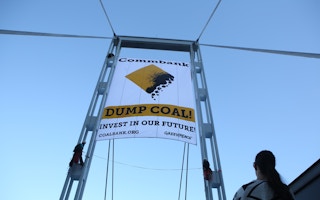Environmental campaigning group Greenpeace Australia Pacific on Friday launched a high-profile protest outside Australian financial giant Commonwealth Bank’s headquarters, calling on the bank to stop funding coal and other polluting fossil fuels.
To continue reading, subscribe to Eco‑Business.
There's something for everyone. We offer a range of subscription plans.
- Access our stories and receive our Insights Weekly newsletter with the free EB Member plan.
- Unlock unlimited access to our content and archive with EB Circle.
- Publish your content with EB Premium.
Two Greenpeace activists scaled a bridge outside the bank’s headquarters in Sydney’s Darling Harbour in the early hours of the morning and unfurled a huge banner urging the bank to “dump coal; invest in our future”; this was accompanied by volunteers on the ground who handed out pamphlets to members of the public and the bank’s staff.
This incident is the latest move in a sustained campaign against Commonwealth Bank, or CommBank, which according to non-profit group Market Forces, lent almost A$3.9 billion to fossil fuel projects last year; the highest among any Australian Bank.
Market Forces also estimates CommBank’s finance for renewables last year to A$846 million; that’s about $4.60 of fossil fuel financing for every dollar of renewables financing. CommBank, however, has a different figure, claiming that its exposure to renewable energy generation was A$2.3 billion as of December last year, up from A$1.7 billion a year before.
Nikola Casule, climate and energy campaigner, Greenpeace, in a statement called on the bank’s chief executive officer Ian Narev and its board of directors to live up to their environmental commitments and rule out involvement in any new fossil fuels extraction projects, or in the expansion of existing projects, a move Westpac made in late April.
CommBank in late 2015 released an environmental policy that acknowledges the harm done by climate change, and the need to act quickly to reduce carbon emissions. It also ranked as the most sustainable Australian company and bank in the 2016 and 2017 editions of the Global 100 Most Sustainable Corporations Index, which is compiled by Canadian research firm Corporate Knights.
In response to demands from campaigners, CommBank released a statement outlining its achievements in renewable energy financing. Its work in this space includes supporting large-scale solar financing projects; investing in New South Wales’ largest wind farm; and launching its first climate bond in March.
When pressed on the topic of reducing financing for coal, a bank spokesperson told Eco-Business: “As a major financial institution we lend to nearly every sector in the economy.”
The spokesperson added: “We believe we need to take a balanced, measured and responsible approach as we support the transition to a low-carbon economy.” They also noted that as of the end of December 2016, Commbank’s lending to renewable electricity was about five times its lending to coal-fired power generation.
Carmichael controversy
Greenpeace campaigners, as well as anti-fossil fuel activists from groups like 350.org Australia, have in recent days slammed CommBank for providing financial services to Indian mining giant Adani for its controversial Carmichael Mine in Queensland.
Activists on Wednesday announced the discovery of a confidential document which revealed the bank has been “secretly facilitating” Adani’s mine plans. The document in question, provided to civil society group Lock the Gate upon request and seen by Eco-Business, is a “statement of reasons” produced by the Queensland Government for granting Adani a water license.
The statement of reasons cannot currently be made public, because doing so would set the clock ticking on a deadline for concerned parties to mount a legal challenge against the license; a process which typically requires lengthy preparation. However, it shows that Adani paid an A$1.6 million license fee to the government from a CommBank account.
Casule told Eco-Business: “Ever since CommBank distanced itself from Adani’s Carmichael mine in late 2015, the bank has been happy to let people think it has nothing to do with the mine”. But the recently uncovered documents show otherwise.
CommBank, however, refuted these claims in a separate statement, calling them a misrepresentation of “the role of ordinary transaction banking accounts used by thousands of Australian businesses and consumers”.
“A transaction account does not equate to business lending or project finance,” said the bank. Transaction accounts allow people and organisations to make payments using their own money, while business lending is a separate affair. The bank added that it applies a strict environmental, social, and governance policy to all lending decisions.
Nevertheless, Greenpeace’s Casule called for greater transparency around the financial and regulatory processes surrounding the controversial project.
“The finance for the Carmichael mine has been shrouded in secrecy from day one,” said Casule, pointing to the fact that the statement of reasons is not publicly available, and the Northern Australia Infrastructure Facility’s refusal to disclose information about a planned A$1 billion loan to Adani.
“It’s time for CommBank to rule out investing in new coal mines, including Carmichael, and help protect treasures like the Great Barrier Reef for future generations,” he added.








